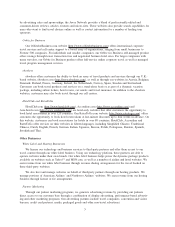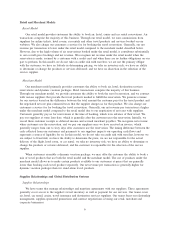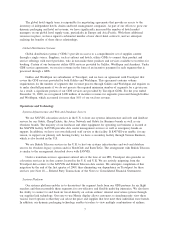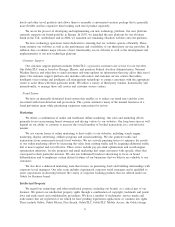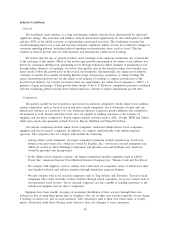Orbitz 2009 Annual Report Download - page 15
Download and view the complete annual report
Please find page 15 of the 2009 Orbitz annual report below. You can navigate through the pages in the report by either clicking on the pages listed below, or by using the keyword search tool below to find specific information within the annual report.We have a significant amount of indebtedness, which could limit the manner in which we operate our
business.
As of December 31, 2008, we had approximately $614 million of outstanding debt under our senior
secured credit agreement. Our substantial level of indebtedness could have important consequences to us,
including the following:
• it may impair our ability to obtain additional financing for working capital, capital expenditures,
acquisitions or general corporate purposes;
• it requires us to use a portion of our cash flows from operations to make debt service payments, which
reduces the funds available to us for other purposes such as potential acquisitions and capital
expenditures;
• because we have a higher level of indebtedness than some of our competitors, it puts us at a
competitive disadvantage and reduces our flexibility in planning for, or responding to, changing
conditions in the economy or our industry, including increased competition; and
• it may make us more vulnerable to general economic downturns and adverse developments in our
business.
The credit agreement requires us to maintain a minimum fixed charge coverage ratio and to not exceed a
maximum total leverage ratio, which declines over the term of the agreement. If we fail to comply with these
covenants and we are unable to obtain a waiver or amendment, our lenders could accelerate the maturity of all
amounts outstanding under our term loan and revolving credit facility and could proceed against the collateral
securing this indebtedness. Furthermore, if this were to occur, there is no assurance that alternative financing
would be available to us at all or at favorable terms, particularly in the wake of the current economic
environment.
In addition, restrictive covenants in our credit agreement specifically limit our ability to, among other
things:
• incur additional indebtedness or enter into guarantees;
• enter into sale or leaseback transactions;
• make new investments, loans or acquisitions;
• sell our assets;
• engage in mergers, consolidations, liquidations or dissolutions; and
• engage in transactions with affiliates.
As a result, we may operate our business differently than if we were not subject to these covenants and
restrictions.
We rely on Travelport to issue letters of credit on our behalf under its credit facility.
As of December 31, 2008, approximately $67 million of letters of credit were issued by Travelport on our
behalf. Under the terms of the Separation Agreement, as amended, Travelport has agreed to continue to issue
and renew letters of credit on our behalf through at least March 31, 2010 and thereafter so long as Travelport
and its affiliates (as defined therein) own at least 50% of our voting stock. Although Travelport is obligated to
issue letters of credit on our behalf, this obligation is subject to certain conditions, including a $75 million
limitation on the aggregate amount of letters of credit that Travelport is required to issue on our behalf at any
given point in time. If we do not have a separate letter of credit facility in place if or when Travelport is no
longer obligated to issue letters of credit on our behalf, or if we exceed the $75 million limitation or if we
require letters of credit denominated in foreign currencies, we would be required to issue letters of credit
under our revolving credit facility, which could significantly reduce our borrowing capacity under our
15


